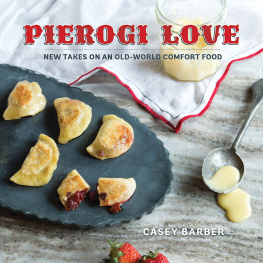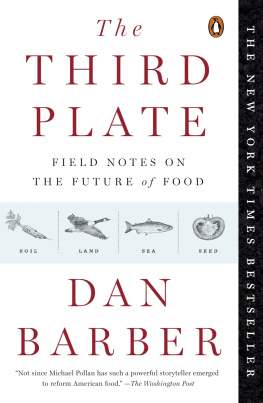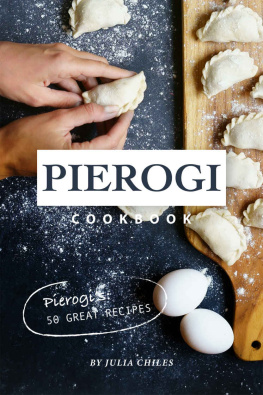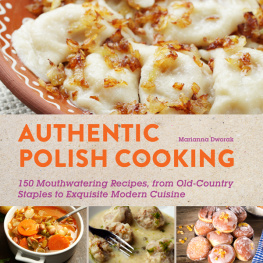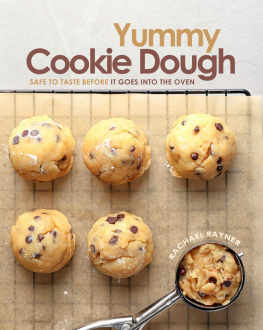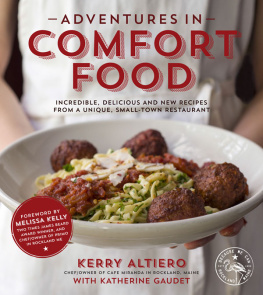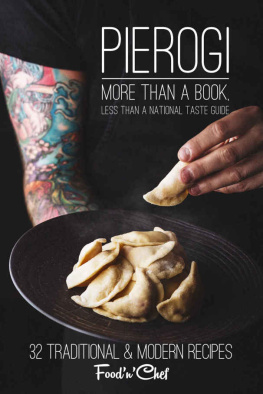Introduction
Growing up in western Pennsylvanias Allegheny Mountains, my culinary touchstones were as provincial as a city slicker would imagine. Nigiri, tom yum, and injera were completely unfamiliar to me for the first fifteen years of my life. But what I lacked in culinary sophistication, I atoned for with my unintentionally immersive studies in the foods of Pittsburghs immigrant population: Italian red sauce rich with pork fat; anise-scented pizzelles; kielbasa and sauerkraut bubbling in the Crock-Pot during the holidays; and plates of pierogies at weekend church fairs.
Even if you dont think you know what a pierogi is, chances are youve laid eyes on one at least once in your life. Quite simply, a pierogi is an Eastern European dumpling. A soft but slightly chewy half-moon of dough traditionally filled with potatoes, cheese, meat, sauerkraut, or fruit, then boiled and served with butter, pan-fried onions, or sour cream, a pierogi is its own special breed of comfort food.
The pierogi goes by different names depending on which country its being eaten in and what its filled with: Russians, Ukrainians, Hungarians, Czechs, Slovaks, Lithuanians, and Romanians have all historically chowed down on pelmeni, vareniki, varenyky, piroti, or kalduny. Even in Poland, it might be known as a pierogi, pirogi, perogi, perogy, pieroshki, or piroshky. No wonder the uninitiated might be confusedfor such a humble food, it gets around.
And though Ill admit we western Pennsylvanians like to think of our region as the epicenter of pierogi pride in AmericaI mean, the Pittsburgh Pirates do have a pierogi mascot race at every home baseball gamewe cant take all the credit. From Chicago, which boasts an immigrant history as rich and plentiful as Pittsburgh, to neighborhoods in New Jersey and Brooklyn settled by Slovak and Ukrainian families, to pockets of Polish populations in Wisconsin, Michigan, and even Nebraska, pierogi lovers pop up throughout the United States.
But theres one problem: most people, even ardent pierogi noshers, associate pierogies with old-world sensibilities and peasant food. With this cookbook, Im rescuing the pierogi from its purgatory in fluorescent-lit, wood-paneled community halls and church basements and bringing it into the modern world. Pierogi Love takes that familiar wrapping and stuffs it with a host of unconventional, innovative, and decidedly non-traditional fillings. If Korean BBQ and tacos can happily co-exist, so can Indian rice pudding and Polish dumplingsor French onion soup, for that matter, or Southern pecan pie, or surprisingly elegant ros-poached pears.
What Im saying is that you might need to sit your grandma down before showing her this book.
Pierogies are unbelievably versatile and malleable. The modern pierogi is a party hosts best friend as a simple freeze-and-serve appetizer; a pop-in-your-mouth game-watching snack that rivals your favorite bar food; a kid-friendly weeknight dinner that boils up in minutes with enough left over for the next days lunch. Its most definitely dessert, especially when theres caramel and chocolate sauce in the mix. And Id venture that some of the sweet versions could give donuts a run for their money when theres a deep fryer involved. (Move over, beignets!)
Once you get started, you wont be able to stop the flood of new filling ideas pouring into your brain. Pierogi dough is a blank canvas for whatever you choose to stuff insidedont stop with the recipes here! I can envision a slew of worldly pierogies, from tikka masala to picadillo. And my jam- and pickle-making friends are already having a field day filling the dough with their own inventive preserves from their pantries.
I hope Pierogi Love encourages you to see this classic food in a new light and inspires you to spread the pierogi love in your own lives.
The Basics
Equipment and Ingredients
You honestly dont need much to make pierogies; after all, cooks around the world have been doing it for centuries without high-tech tools. And while there are molds and presses for assembly line-perfect pierogies, I like to do it the old-fashioned way: by hand. Heres what I use for pierogi-making missions:
Need-To-Have Equipment
Mixing bowls: Have at least three, with one bowl big enough to knead in. A stainless steel bowl is key for the chocolate sauces and marshmallow fluff in the Sweet Pierogies chapter.
Rolling pin: Pick one that feels comfortable in your hands; I love the heft of my silicone-coated rolling pin, but plain wood works just as well.
3-inch cookie cutter: Pierogies should be small enough to eat in one or two bites. A 3-inch cutter gives the perfect dough-to-filling ratio without being too small to stuff. (And its more precise than the Polish grandma method of using an overturned juice glass.)
Rimmed baking sheet: A 9 x 13-inch rimmed baking sheet fits a batch of 24 pierogies snugly and keeps frozen pierogies in place while chilling.
Teaspoon: Though a full complement of measuring spoons comes in handy, the 1-teaspoon measure specifically makes it much easier to get the right amount of filling into each pierogi.
Silicone spatulas: A few quality silicone spatulas (and thicker rounded spoonulas) will serve you well for mixing both dough and fillings.
Small saucepans: A 1-1/2- to 2-quart high-sided saucepan is the workhorse for most of the fillings in the book, as well as for boiling up to 8 pierogies at a time. A very small 1- or 2-cup saucepan is the perfect size for melting the doughs 3 tablespoons of butter as well as for simmering small amounts of liquid and reheating single servings of chocolate sauce.
Pots for boiling and skillets for frying: For boiling full batches of pierogies, grab a 4-to 6-quart stockpot. Youll also need a good, heavy-bottomed skilletlike a 10-inch cast iron frying panfor pan-frying pierogies.
Kitchen scale: Trust me when I say a kitchen scale is truly essential and not a fussy tool. Its actually a lifesaver for messy cooks and those who quail at the exact science of baking. Dump an ingredient (flour, nuts, cheese, whatever) into a bowl set on the scale; zero the scale out; dump the next ingredient in; repeat. Because everything goes into one bowl, you wont have to search foror washa sinkful of measuring cups, and its much more accurate to boot!
Every recipe in the book includes weight measurements in ounces and grams as well as volume. Use what youre most comfortable with, but I encourage you to give the kitchen scale a goOXO and Salter models are affordable and widely available.

